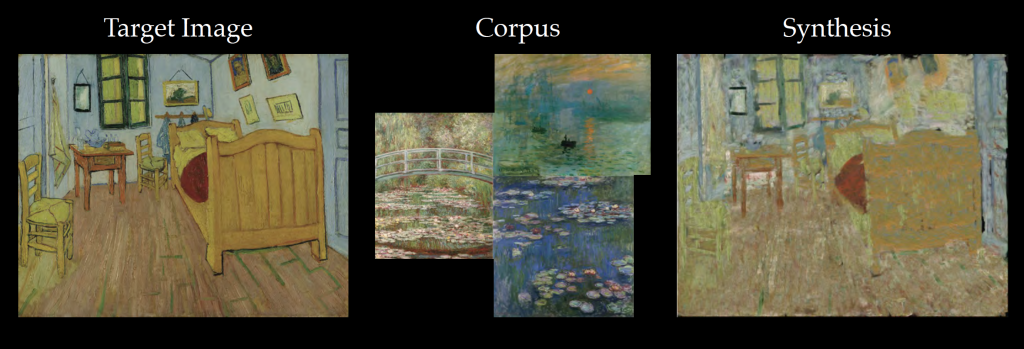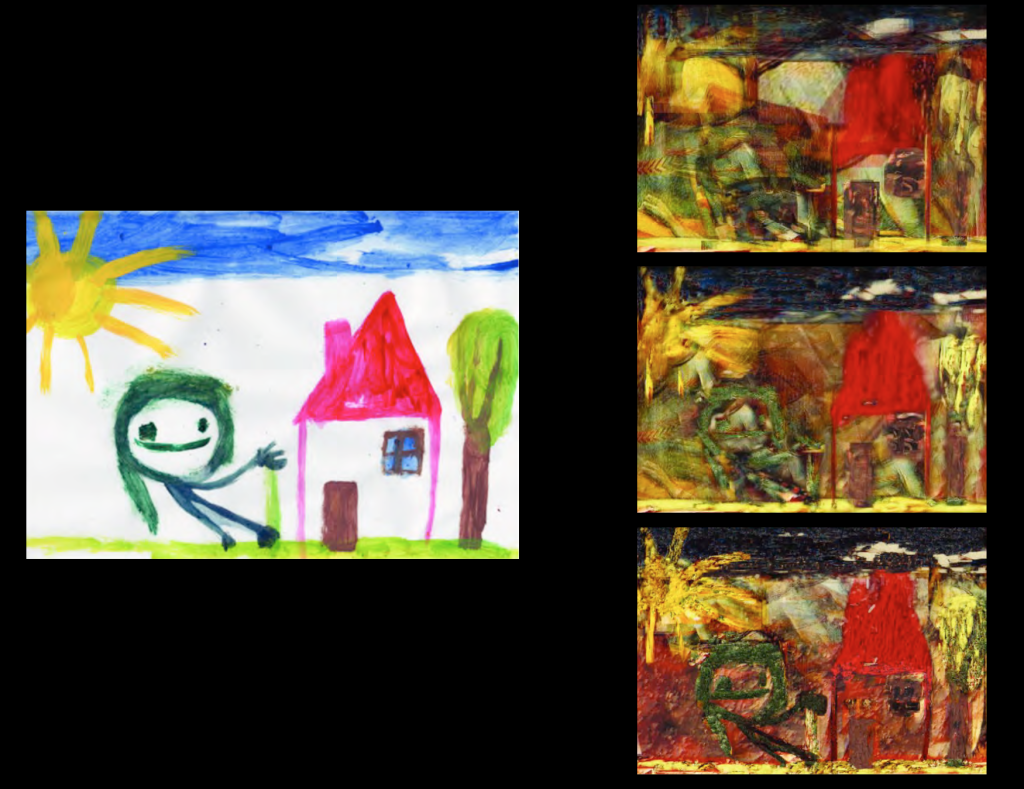Parag K. Mital, Mick Grierson, and Tim J. Smith. 2013. Corpus-based visual synthesis: an approach for artistic stylization. In Proceedings of the ACM Symposium on Applied Perception (SAP ’13). ACM, New York, NY, USA, 51-58. DOI=10.1145/2492494.2492505 http://doi.acm.org/10.1145/2492494.2492505 [online]
Abstract
We investigate an approach to the artistic stylization of photographic images and videos that uses an understanding of the role of abstract representations in art and perception. We first learn a database of representations from a corpus of images or image sequences. Using this database, our approach synthesizes a target image or video by matching geometric representations in the target to the closest matches in the database based on their shape and color similarity. We show how changing a few parameters of the synthesis process can result in stylizations that represent aesthetics associated with Impressionist, Cubist, and Abstract Expressionist paintings. As the stylization process is fast enough to work in real-time, our approach can also be used to learn and synthesize the same camera image, even aggregating the database with each new video frame in real-time, a process we call “Memory Mosaicing”. Finally, we report the user feedback of 21 participants using an augmented reality version of “Memory Mosaicing” in an installation called “Augmented Reality Hallucinations”, where the target scene and database came from a camera mounted on augmented reality goggles. This information was collected during an exhibition of 15,000 participants at the Digital Design Weekend at the Victoria and Albert Museum (co-located during the London Design Festival).
Introduction
Despite its apparent precision, our perception of reality is not representative of the way that we see. For instance, the light coming to our eyes is distorted, upside-down, and constantly disrupted with each movement of the eye. How can this noisy process ever constitute our experience of the visual world? Numerous theories have argued that in order to perceive the world as a continuous and richly detailed one, our vision system must use abstracted representations of the world \cite{Marr1982}. It is argued that these representations are created by grouping together coherent visual features that resemble abstract forms – such as geometrical primitives. Grouping such primitives together eventually leads to the formation of semantic representations such as objects. Importantly, the representations used in vision are not necessarily what we perceive, but are what we use in order to help us perceive. As a result, these representations are likely to remove details that are unimportant to a person’s ongoing task while making other details more explicit.
Artists are well aware of the role of representation in perception. By leaving out particular details from a visual scene and accentuating others, they are able to direct a viewer’s attention within a visual medium, influencing their perception \cite{Haeberli1990,Zimmer2003}. Picasso once famously said, “I paint forms as I think them, not as I see them” \cite{Hughes1991}. As one of the pioneers of Cubism, Picasso wanted to represent the fact that our perception of an object is based on all possible views of it. He did so by compressing all views of an object into a synthesized one built using abstracted shape primitives. Other movements in art can also be characterized as utilizing representations formed through geometrical primitives. In Impressionist painting, these forms are often described by a dense number of short and visible brush strokes. In Abstract Expressionist painting, the primitives are again dense, though tended to be of much larger strokes in an attempt to abstract away as much detail of a real scene as possible.
In this paper, we investigate an approach to the artistic stylization of photographic images and videos through the use abstracted shape representations. The representations that are built by this method can be varied in size and density using a process that allows the user to manipulate parameters in real-time. Our system first learns a database of representations from a corpus of images. It then synthesizes a target image or video by matching geometric representations in the target to the closest matches in the database. We show how changing the parameters of the synthesis process results in stylizations that represent aesthetics associated with Impressionist, Cubist, and Abstract Expressionist paintings. As the stylization process is fast enough to work in real-time, this approach can also be used to learn and synthesize the same camera image, even aggregating the database with each new video frame in real-time, a process we call “Memory Mosaicing”. Finally, we report the feedback of 21 participants using an augmented reality version of “Memory Mosaicing” in an installation called “Augmented Reality Hallucinations”, where the target scene and database came from a camera mounted on augmented reality goggles.
Examples
Paper and Presentation
Read more: acm-sap-opt
ACM SAP 2013 Presentation: ACM SAP Presentation





